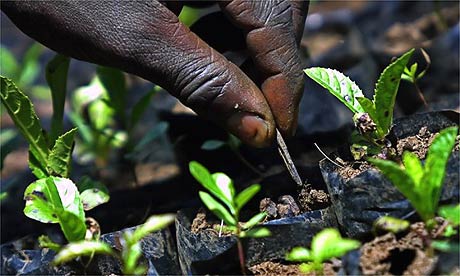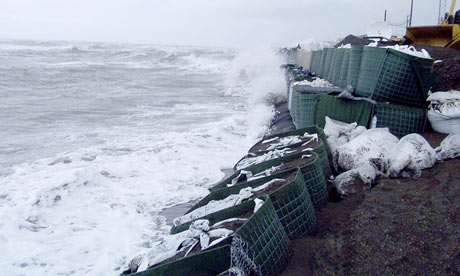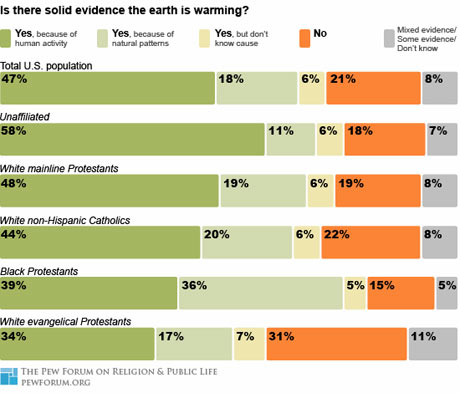NGOs who oppose geo-engineering are running the risk of climatic catastrophe
- guardian.co.uk, Wednesday 15 April 2009 14.41 BST

Planting trees for a carbon offset project in Kenya. Growing trees is one way of stocking carbon out of the linked ocean-atmosphere system. Photograph: Tony Karumba/AFP/Getty
Interviewed last week, John Holdren, President Obama's chief scientific adviser, said that drastic measures should not be "off the table" in discussions on how best to tackle climate change and that geo-engineering could not be ruled out. Making clear these were his personal views, he said: "It's got to be looked at. We don't have the luxury of taking any approach off the table."
He's right. We don't have that luxury – not only because the Kyoto protocol's first phase, running to 2012, is manifestly failing, but because the emissions reduction approach that it embodies cannot succeed. It is manifestly failing because emissions are going ahead faster than even the worst scenarios considered by the IPCC, which provides scientific assessments to the UN Climate Convention and because many rich countries are on course to fall short of their emissions reductions commitments.
Research since the IPCC's last assessment reveals that the threat of climatic disaster is more serious than previously supposed. Several threats exist but the most imminent is probably a collapse of substantial areas of land-based ice into the oceans, as studies of ancient climates show happened in previous warming phases. This seems likely to be due to the lubrication of Greenland's ice floes by water that accumulates year after year, with warmer summers melting the surface and rivers of melt-water flowing down crevasses to the bedrock, making the underside of the ice increasingly mushy and prone to slip down towards the ocean. Reports from Greenland, of increased frequency of "ice-quakes", suggest that areas of the ice cover have slipped and bumped into other areas that are still stuck. When the last bit gives way there may be an unstoppable rush of ice into the ocean, as with ancient warming phases, raising ocean levels by several metres over a few decades.
"Probably"? "Likely"? "Suggest"? "Maybe"? Yes, all is uncertain and the models are inadequate. But you don't drive full-speed down a twisty lane on a foggy winter's night hoping there's no ice round the next bend. A measure of the threat is the accumulation of warmth from successive summers, which is making the glaciers' undersides increasingly mushy. Even a deeply implausible reduction of emissions to zero in 25 years sees that measure treble over the next half-century with no end in sight.
So something more than emissions reductions is needed. We must take CO2 out of the atmosphere or prevent some of the sun's radiation from reaching the surface. But geo-engineering is usually thought of as shielding the earth from solar radiation by whitening clouds and by putting reflectors in space between earth and sun. The latter seems difficult to reverse and perhaps a very last resort. But whitening clouds can be quickly halted. It involves putting sulphur aerosols into the clouds in amounts that are trivial compared with the effects of either volcanic eruptions or coal burning worldwide. Or injecting saltwater micro-particles into ocean clouds which, whitened, then rain slightly salty water back into the oceans.
Amazing though it may seem, these apparently hopeful options are opposed by NGOs that seem more willing to run the risk of climatic catastrophe than deviate from the emissions reductions gospel. Their concern seems to be that geo-engineering will result in relaxed pressure to reduce emissions, which neglects the reality that more ambitious commitments will obviously go with increased capability to mitigate. They even oppose research, unlike Holdren's "it's got to be looked at".
The British researcher Tim Lenton uses the term geo-engineering to mean any way of cooling the earth that is not emissions reductions (even growing trees, which is included under the Kyoto protocol). His definition puts me – somewhat to my surprise – among the ranks of geo-engineers, as I have long advocated widespread tree-planting programmes, such as those initiated by the Nobel Peace laureate Wangari Muta Maathai, founder of the Green Belt Movement, which has planted more than 30m trees across Kenya.
Growing trees is one way of stocking carbon out of the linked ocean-atmosphere system. Others advocate fuelling power stations with energy crops and capturing CO2 from flue gases and piping them into deep saline aquifers. A third option is biochar, current darling of the policy community, which promises not only to store carbon in the soil but to provide rural energy supplies and raise soil productivity as the basis for sustainable rural development. Yet even this win-win-win prospect is rejected by 129 NGOs who have declared "Biochar – a new big threat to people land and ecosystems". I would rather listen to the 1,500 poor subsistence farmers in Kumba, south-west Cameroon, who are already experiencing its benefits and who deny rich-country NGO claims that civil society in the developing world rejects biochar.
• Peter Read is an honorary research fellow at the Centre for Energy Research, Massey University, New Zealand


